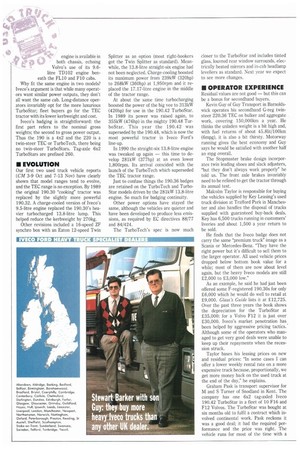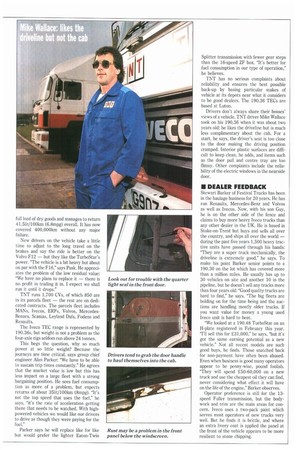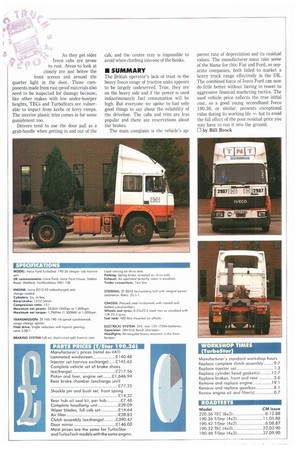W it e first tested the W it e first tested the 190.36 TurboStar
Page 31

Page 32

Page 33

Page 34

If you've noticed an error in this article please click here to report it so we can fix it.
4x2 tractive unit early in 1988, 12 months after was introduced. We liked the power and high level of torque supplied by the big, low-revving engine which gave above average journey times with little driver effort. Fuel consumption benefited accordingly, with a return of 38.691it/100km (7.3mPg) overall — virtually identical to the 220.36 TEC twin-steer tested later that year. Limited traction gave us some cause for concern: on the hill restart tests wheelspin stopped us climbing anything steeper than a 20% (1-in-5) gradient. In practical terms this proved to be perfectly adequate as on the move we did not need to drop below third gear. This was just as well as gear selection with the ZF 16-sPeed synchromesh gearbox was slow in the lower half of the rangechange.
Our six-month-old Turbo Star was already showing signs of wear inside the cab. The trim above the passenger door had worked loose and the surrounds to the header rail Shelves were worn. A combination of the low revving engine and very efficient noise insulation made for a very quiet cab.
The high-backed and air-suspended seat's wide range of adjustments added to the comfort; the steering wheel can be set at any angle. Power steering made it easy to apply full lock at low speed, but this did cause the clamp bolt at the end of the tie bar to contact the shock absorber with a disquieting clonk.
Our test vehicle carried a spare wheel, but the extra weight was largely offset by optional aluminium rims fitted. With an unladen weight of 7.4 tonnes it came up about 0.5 tonnes short on payload when compared with the Cumminspowered ERF E14.35.
pParts prices don't look far out of line generally, although the piston liner set costs 50% more than for a large Cummins engine, for example. We will be publishing a "Workshop \ ways" on the heavy Iveco tractive unit range, in our Workshop supplement within the 19 December issue of Commercial Motor.
engine is available in both chassis, echoing Volvo's use of its 9.6litre TD102 engine ben eath the FL10 and F10 cabs.
Why fit the same engine in two models? Iveco's argument is that while many operators want similar power outputs, they don't all want the same cab. Long-distance operators invariably opt for the more luxurious TurboStar; fleet buyers go for the TEC tractor with its lower kerbweight and cost.
Iveco's badging is straightforward: the first part refers to the nominal gross weights; the second to gross power output. Thus the 190 is a 4x2 and the 220 is a twin-steer TEC or TurboTech, there being no twin-steer TurboStars. Tag-axle 6x2 TurboStars are prefixed 260.
• EVOLUTION
Our first two used truck vehicle reports (CM 3-9 Oct and 7-13 Nov) have clearly shown that model ranges tend to evolve, and the TEC range is no exception. By 1989 the original 190.30 "cooking" tractor was replaced by the slightly more powerful 190.32. A charge-cooled version of Iveco's 9.5-litre engine replaced the 190.30's heavier turbocharged 13.8-litre lump. This helped reduce the kerbweight by 270kg.
Other revisions included a 16-speed ZF synchro box with an Eaton 12-speed Twin Splitter as an option (most right-hookers got the Twin Splitter as standard). Meanwhile, the 13.8-litre straight-six engine had not been neglected. Charge-cooling boosted its maximum power from 239kW (320hp) to 268kW (360hp) at 1,950rpm and it replaced the 17.17-litre engine in the middle of the tractor range.
At about the same time turbocharging boosted the power of the big vee to 313kW (420hp) for use in the 190.42 TurboStar. In 1989 its power was raised again, to 355kW (476hp) in the mighty 190.48 TurboStar. This year the 190.42 was superseded by the 190.48, which is now the most powerful tractor in Iveco Ford's line-up.
In 1990 the straight-six 13.8-litre engine was tweaked up again — this time to develop 281kW (377hp) at an even lower 1,800rpm. Its arrival coincided with the launch of the TurboTech which superseded the TEC tractor range.
Just to confuse things the 190.36 badges are retained on the TurboTech and TurboStar models driven by the 281kW 13.8-litre engine. So much for badging continuity.
Other power options have stayed the same, although the vehicles are quieter and have been developed to produce less emissions, as required by EC directives 88/77 and 84/424.
The TurboTech's spec is now much closer to the TurboStar and includes tinted glass, louvred rear window surrounds, electrically heated mirrors and in-cab headlamp levellers as standard. Next year we expect to see more changes.
• OPERATOR EXPERIENCE
Residual values are not good — but this can be a bonus for secondhand buyers.
Kevin Guy of Guy Transport in Barnoldswick operates his secondhand G-reg twinsteer 220.36 TEC on bulker and aggregate . work, covering 150,000Iun a year. He thinks the unladen weight is a bit high and, with fuel returns of about 45.81it/100km (6mpg), it is also a bit thirsty. Motorway running gives the best economy and Guy says he would be satisfied with another half an mpg overall.
The Stopmaster brake design incorporates twin leading shoes and slack adjusters, "but they don't always work properly" he told us. The front axle brakes invariably need to be relined to get the tractor through its annual test.
Malcolm Taylor is responsible for buying the vehicles supplied by Key Leasing's used truck division at Trafford Park in Manchester and also handles the disposal of trucks supplied with guaranteed buy-back deals. Key has 6,500 trucks running in customers' liveries and about 1,500 a year return to be sold.
He finds that the Iveco badge does not carry the same "premium truck" image as a Scania or Mercedes-Benz. "They have the right power but it's difficult to sell them to the larger operator. All used vehicle prices dropped below bottom book value for a while; most of them are now about level again, but the heavy Iveco models are still £2,000 to 0,000 low."
As an example, he said he had just been offered some F-registered 190.30s for only £6,000 which he would do well to retail at £9,000. Glass's Guide lists it at £12,725. Over the past three years the book shows the depreciation for the TurboStar at £35,000: for a Volvo F12 it is just over £30,000. Iveco's market penetration has been helped by aggressive pricing tactics. Although some of the operators who managed to get very good deals were unable to keep up their repayments when the recession struck.
Taylor bases his leasing prices on new and residual prices: "In some cases I can offer a lower weekly rental rate on a more expensive truck because, proportionally, we get more money back on the used truck at the end of the day," he explains.
Graham Pask is transport supervisor for M and S Turner of Snodland in Kent. The company has one 6x2 tag-axled Iveco 190.42 TurboStar in a fleet of 10 F16 and F12 Volvos, The TurboStar was bought at six months old to fulfil a contract which involved continental work. Pask reckons it was a good deal; it had the required performance and the price was right. The vehicle runs for most of the time with a full load of dry goods and manages to return 41.51it/100km (6.8mpg) overall. It has now covered 400,000km without any major failure.
New drivers on the vehicle take a little time to adjust to the long travel on the brakes and say the ride is better on the Volvo F12 — but they like the TurboStar's power. "The vehicle is a bit heavy but about on par with the F16," says Pask. He appreciates the problem of the low residual value: "We have no plans to replace it — there is no profit in trading it in. I expect we shall run it until it drops."
TNT runs 1,700 CVs, of which 850 are in its parcels fleet — the rest are on dedicated contracts. The parcels fleet includes MANs, Ivecos, ERFs, Volvos, MercedesBenzes, Scanias, Leyland Dafs, Fodens and Renaults.
The Iveco TEC range is represented by 190.36s, but weight is not a problem as the four-axle rigs seldom run above 24 tonnes.
This begs the question, why so much power at so little weight? Because the journeys are time critical, says group chief engineer Alan Parker: "We have to be able to sustain trip times constantly." He agrees that the market value is low but this has less impact on a large fleet with a strong bargaining position. He sees fuel consumption as more of a problem, but expects returns of about 351it/1001on (8mpg). It's not the top speed that uses the fuel," he says, "it's the rate of acceleration getting there that needs to be watched. With highpowered vehicles we would like our drivers to drive as though they were paying for the fuel."
Parker says he will replace like for like but would prefer the lighter Eaton-Twin Splitter transmission with fewer gear steps than the 16-speed ZF box. "It's better for fuel consumption in our type of operation," he believes.
TNT has no serious complaints about reliability and ensures the best possible back-up by basing particular makes of vehicle at its depots near what it considers to be good dealers. The 190.36 TECs are based at Luton.
Drivers don't always share their bosses' views of a vehicle. TNT driver Mike Wallace took on his 190.36 when it was about two years old: he likes the driveline but is much less complimentary about the cab. For a start, he says, the driver's seat is too close to the door making the driving position cramped. Interior plastic surfaces are difficult to keep clean, he adds, and items such as the door pull and centre tray are too flimsy. Other complaints include the reliability of the electric windows in the nearside door.
• DEALER FEEDBACK
Stewart Barker of Festival Trucks has been in the haulage business for 20 years. He has run Renaults, Mercedes-Benz and Volvos as well as Ivecos. Now, with his son Guy, he is on the other side of the fence and claims to buy more heavy Iveco trucks than any other dealer in the UK. He is based in Stoke-on-Trent but buys and sells all over the country, and ships all over the world — during the past five years 1,500 heavy tractive units have passed through his hands: "They are a super truck mechanically, the driveline is extremely good," he says. To make his point Barker senior points to a 190.30 on the lot which has covered more than a million miles. He usually has up to 30 vehicles on site and another 10 in the pipeline, but he doesn't sell any trucks more than four years old: "Good quality trucks are hard to find," he says. "The big fleets are holding on for the time being and the auctions are handling mostly older trucks. If you want value for money a young used lveco unit is hard to beat.
"We looked at a 190.48 TurboStar on an H-plate registered in February this year. "I'll sell this for £31,000," he says, "but it's got the same earning potential as a new vehicle." Not all recent models are such good buys, he finds. Those snatched back for non-payment have often been abused. Even when business is good many operators appear to be penny-wise, pound foolish. "They will spend £50-60,000 on a new truck and use the cheapest oil they can find, never considering what effect it will have on the life of the engine," Barker observes.
Operator preference is still for the 13speed Fuller transmission, but the bodywork and trim are the main areas for concern. Iveco uses a two-pack paint which serves most operators of new trucks very well. But he finds it is brittle, and where an extra livery coat is applied the panel at the front of the vehicle appears to be more resilient to stone chipping.
As they get older
a tp Iveco cabs are prone to rust. Areas to look at closely are just below the front screen and around the quarter light in the door. Those components made from rust-proof materials also need to be inspected for damage because, like other makes with low under-bumper heights, TECs and TurboStars are vulnerable to impact from kerbs or ferry ramps. The interior plastic trim comes in for some punishment too.
Drivers tend to use the door pull as a grab-handle when getting in and out of the
cab, and the centre tray is impossible to avoid when climbing into one of the bunks.
• SUMMARY
The British operator's lack of trust in the heavy Iveco range of tractive units appears to be largely undeserved. True, they are on the heavy side and if the power is used indiscriminately fuel consumption will be high. But everyone we spoke to had only good things to say about the reliability of the driveline. The cabs and trim are less popular and there are reservations about the brakes.
The main complaint is the vehicle's ap
parent rate of depreciation and its residual values. The manufacturer must take some of the blame for this: Fiat and Ford. as separate companies, both failed to market a heavy truck range effectively in the UK. The combined force of Iveco Ford can now do little better without having to resort to aggressive financial marketing tactics. The used vehicle price reflects the true initial cost, so a good young secondhand Iveco 190.36, or similar, presents exceptional value during its working life — but to avoid the full effect of the poor residual price you may have to run it into the ground.
0 by Bill Brock
























































































